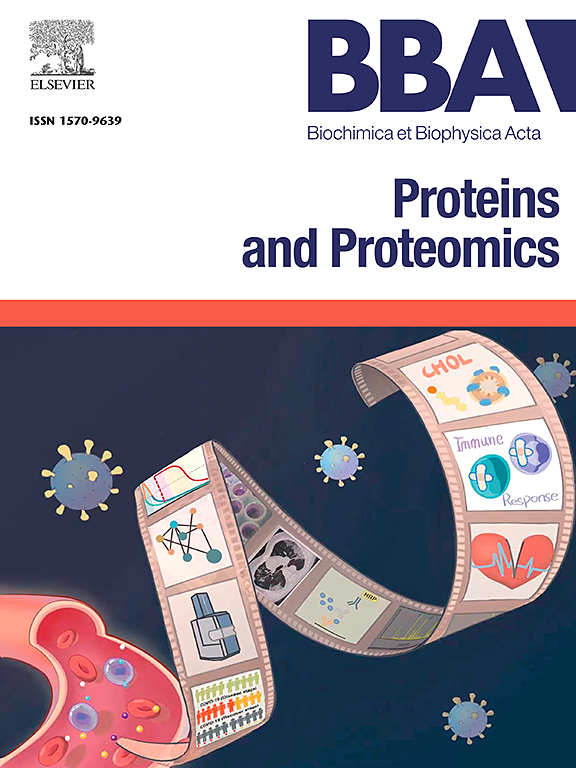Biochemical and kinetic properties of quinone oxidoreductase from Leishmania orientalis, a member of medium-chain dehydrogenase/reductase superfamily
IF 2.3
4区 生物学
Q3 BIOCHEMISTRY & MOLECULAR BIOLOGY
Biochimica et biophysica acta. Proteins and proteomics
Pub Date : 2025-06-20
DOI:10.1016/j.bbapap.2025.141087
引用次数: 0
Abstract
Soluble quinone oxidoreductase (QOR) is an attractive target for treating leishmaniasis. In this study, a QOR from Leishmania orientalis PCM2 (LoQOR) was identified as a member of non![]() Zn2+ medium-chain dehydrogenase/reductase (MDR) superfamily. Using steady-state and rapid kinetics approaches, it was found that LoQOR catalyzes the electron transfer from NADH to menadione via ping-pong kinetics which is unusual for this enzyme. The reaction mechanism was proposed accordingly. The modeled structures created by AlphaFold version 3.0 revealed crucial residues, i.e., Thr131, Tyr134, and Arg268, which may involve the binding to carboxamide group of the NADH nicotinamide ring. The kinetic analysis of the LoQOR mutants compared to the wild-type revealed that these residues are not essential for overall catalysis. However, the kinetic mechanism of Tyr134Phe, Tyr134His, and Arg268Gln mutants has shifted to the ternary complex (LoQOR:NADH:menadione) model, except for Thr131Val and Arg268Lys mutants. It is hypothesized that Tyr134 and Arg268 are likely responsible for determining the mode of the catalytic mechanism. Hence, our findings here provide a fundamental insight into the MDR-type QORs and other related non-metal enzymes in the MDR superfamily.
Zn2+ medium-chain dehydrogenase/reductase (MDR) superfamily. Using steady-state and rapid kinetics approaches, it was found that LoQOR catalyzes the electron transfer from NADH to menadione via ping-pong kinetics which is unusual for this enzyme. The reaction mechanism was proposed accordingly. The modeled structures created by AlphaFold version 3.0 revealed crucial residues, i.e., Thr131, Tyr134, and Arg268, which may involve the binding to carboxamide group of the NADH nicotinamide ring. The kinetic analysis of the LoQOR mutants compared to the wild-type revealed that these residues are not essential for overall catalysis. However, the kinetic mechanism of Tyr134Phe, Tyr134His, and Arg268Gln mutants has shifted to the ternary complex (LoQOR:NADH:menadione) model, except for Thr131Val and Arg268Lys mutants. It is hypothesized that Tyr134 and Arg268 are likely responsible for determining the mode of the catalytic mechanism. Hence, our findings here provide a fundamental insight into the MDR-type QORs and other related non-metal enzymes in the MDR superfamily.

东方利什曼原虫中链脱氢酶/还原酶超家族成员醌氧化还原酶的生化和动力学性质
可溶性醌氧化还原酶(QOR)是治疗利什曼病的一个有吸引力的靶点。本研究从东方利什曼原虫PCM2 (LoQOR)中鉴定出一个非zn2 +中链脱氢酶/还原酶(MDR)超家族成员。利用稳态和快速动力学方法,发现LoQOR通过乒乓动力学催化NADH向甲萘醌的电子转移,这在该酶中是不常见的。据此提出了反应机理。AlphaFold 3.0构建的模型结构揭示了关键残基,即Thr131、Tyr134和Arg268,它们可能与NADH烟酰胺环的羧基结合有关。与野生型相比,LoQOR突变体的动力学分析表明,这些残基对整体催化不是必需的。然而,除了Thr131Val和Arg268Lys突变体外,Tyr134Phe、Tyr134His和Arg268Gln突变体的动力学机制已经转向三元配合物(LoQOR:NADH:menadione)模型。我们推测Tyr134和Arg268可能决定了催化机制的模式。因此,我们的研究结果为MDR型qor和MDR超家族中的其他相关非金属酶提供了基本的见解。
本文章由计算机程序翻译,如有差异,请以英文原文为准。
求助全文
约1分钟内获得全文
求助全文
来源期刊
CiteScore
8.00
自引率
0.00%
发文量
55
审稿时长
33 days
期刊介绍:
BBA Proteins and Proteomics covers protein structure conformation and dynamics; protein folding; protein-ligand interactions; enzyme mechanisms, models and kinetics; protein physical properties and spectroscopy; and proteomics and bioinformatics analyses of protein structure, protein function, or protein regulation.

 求助内容:
求助内容: 应助结果提醒方式:
应助结果提醒方式:


